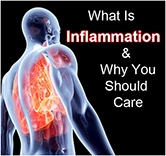Have You Been Living With Your Killer for Years?

It’s a dramatic title. I know. But inflammation is nothing to brush aside. Inflammation will kill us: either directly or indirectly.
But what is inflammation? Inflammation has become a buzz-word for physicians, social media, and health magazines alike but how many of us really understand what it means?
“Imagine taking a stiff wire brush and rubbing it repeatedly over soft skin until it becomes red and almost to the point of bleeding. Let’s pretend you keep this up several times a day, every day for 5 years. If you could tolerate this painful brushing, you would have a bleeding, swollen, infected area that became worse with each repeated injury. This is a good way to visualize the inflammatory process that could be happening in your body right now.” This illustration, given by world-renown cardiovascular surgeon Dr. Lundell, is a wonderful illustration on inflammation and the damage it can do in your body.1
Did you know that diabetes, heart disease, some forms of cancer, Alzheimer’s disease, psoriasis, osteoporosis, Parkinson’s disease, chronic kidney disease, fatty liver disease, and inflammatory bowel disease (IBD) are all believed to have a relationship with inflammation? Whether inflammation is the cause or a mechanism that perpetuates these diseases in unclear for most of these conditions, but one thing is clear: by eliminating chronic inflammation we can limit the development or progression of these diseases.
Did you know that inflammation was designed to be protective in your body? Let’s start by looking at how the inflammatory process is supposed to work, then we’ll address where it goes very, very wrong in many of our bodies.
Let’s use the visual of a splinter going into our finger. This triggers an immunological response. Don’t check out on me here. That just means a response from your immune system (which I am about to describe). When that splinter goes into your finger several things happen at once. Spread throughout our bodies we have special cells whose job is to stand sentinel for injury and alert the immune system that there is a wound that needs addressed. Each of these sentinel cells has a specific role. Mast cells, for example, release histamine (yes, this is the same compound used in an allergic response, but this is a different context in the body). Histamine makes the small vessels nearby (called capillaries) leak slightly allowing for part of the blood called plasma to come through, which acts like a thickening agent in the tissues nearby to slow down any bacteria that may have invaded with the splinter. This gives other immune cells time to gather to the injured area and contains the potentially present bacteria to one area. At the same time the mast cells are releasing their histamine, another specialized sentinel cell called macrophages, begin to attack the area immediately trying to surround and break down anything that’s not your body tissue (bacteria, the wood from the splinter, dirt, etc.). While they’re doing this, they’re also releasing chemicals called cytokines. This is one specific type of messenger signal that physicians often refer to as “inflammatory markers.” These cytokines spread through the bloodstream and tell your other immune cells that there is a problem. Think of these cytokines as dispatchers at the police station. If a police officer sees a threat and needs reinforcement, they have the dispatcher call in other units to the area. As cytokines do their job, more and more immune cells flood the area, each with their own specializations. They destroy any invading agents present (bacteria, virus, etc.) and heal the damaged tissue. This whole process is called innate immunity (meaning that we’re born with it). Once things are under control, the body is supposed to start producing agents that breakdown the cytokines and stop production of more cytokines. Everything (and all of the immune cells) should go back to normal, every sentinel should return to their station, crisis averted.2 In theory.
What would happen if we couldn’t turn off the “WE NEED HELP!” message the cytokines are producing? Your immune system would be in a constant frenzy, seeing threat where there is not threat. Or maybe that message is constantly being produced because there is always a threat. No matter the cause, a constant, long-term elevation of immune markers is a condition referred to as chronic inflammation. TIME magazine gave an excellent illustration of chronic inflammation in their 2004 article titled, “The Fires Within.”2 Chronic inflammation is like a small child picking at their scab over and over again. We know it’s not the best way to heal, but sometimes the right way, or the most efficient way, isn’t the method we choose. That’s what happens when we are chronically inflamed. Our bodies begin to perceive threats where there are none (or maybe the body is always being threatened and it’s just trying to survive!) and disease thrives or potentially even develops in this environment.
So what causes this inflammation in the first place? Sometimes, like the splinter example, it’s a physical injury. Sometimes our genes play a role. But did you know that cortisol (a hormone that is elevated in response to stress) can have the same effect in the body?3 Did you know that eating foods high in refined sugar or unhealthy fats can have an inflammatory effect?1 Did you know that moderate exercise on a daily basis can help reduce chronic inflammation?2 Did you know that working out excessively on a daily basis can increase inflammatory levels in your body? Our lifestyles play more of a role that you would imagine. Want to know more details on how these choices affect our inflammation levels? Check out the links at the end of this post.
So next time you think about reaching for that donut/chips/diet soda when you’re stressed, remember, that’s just a double dose of a wire brush to your very sensitive, already abused body. There’s nothing like a visual of rubbing our delicate tissue raw to help us realize the dangerous potential that our choices have for our immediate and long-term health.
But it’s not just enough to know our bodies are in danger. What can we do about it? What can you do yourself to lower inflammatory levels in your body? Start by cutting out the following behaviors that promote inflammation: stress, over-exercising, poor sleep, poor blood sugar control, and social behaviors such as tobacco use.3 Next, begin incorporating behaviors that help reduce inflammation levels- make sure you’re exercising 30 minutes per day and that you’re getting 6-8 hours of sleep each night. And don’t forget your food choices! That alone is 3-5 choices per day that are either pro-inflammatory or anti-inflammatory! Not sure where to start with dietary changes? Begin with our 21 Day July challenge! Leave us a comment on Facebook to let us know you’re participating. Need more support? We’re here to serve our patients. Let us know how we can help or invite a friend to LIKE the challenge. What about your co-workers? Doing these challenges as a group helps you all become healthier and makes your support system stronger.
For notifications of blog postings, healthy recipe and fitness ideas, as well as weekly fitness ideas make sure to LIKE our Facebook Page.
At our office we’re a fan of using anti-inflammatory nutrients as a short-term way of achieving lowered inflammation levels. Are we making those recommendations here? Nope. Everybody’s body is different. You’ll find at Healthy Living Dallas that we won’t give you a general supplement recommendation. We want to know what your body wants and needs and we can fill those gaps accordingly. So please understand that we will not answer questions regarding supplementation, dosages, etc. without seeing our in-depth panel of bloodwork and knowing your health history intimately. Supplements are like garage sales: one mans trash is another mans treasure and we know enough to know while sometimes blindly making supplement recommendations is beneficial, it is often a waste of money for the patient and can be downright dangerous for others depending on other health factors.
Do you want to know your inflammatory markers? At Healthy Living Dallas we’re all about prevention of disease and the treatment of disease at the root level. We understand that sometimes prescriptions are necessary if your body is in a very dangerous place. But we also believe in working on the underlying causes at the same time. In this case, that means knowing and monitoring your inflammatory markers. Part of our new patient bloodwork that is most likely covered by your insurance includes a full inflammatory panel. Because knowledge is power.
For more information, be sure to read our other blog postings on inflammation including: How a Donut Can Cause a Heart Attack, The Foods That Inflame Us, How Food Can Fight Inflammation, Chronic Inflammation & Disease, and more.
- (2012, March 1). World Renown Heart Surgeon Speaks Out on What Really Causes Heart Disease. Retrieved from http://preventdisease.com/news/12/030112_World-Renown-Heart-Surgeon-Speaks-Out-On-What-Really-Causes-Heart-Disease.shtml.
- Gorman, C. , Park, A., & Dell, K. (2004, July). The Fires Within. Retrieved from http://www.lifeextension.com/Magazine/2004/7/report_time/Page-01.
- Marquis, D. (2013, March 7). How Inflammation Affects Every Aspect of Your Health. Retrieved from http://articles.mercola.com/sites/articles/archive/2013/03/07/inflammation-triggers-disease-symptoms.aspx
Dallas
3800 San Jacinto
Dallas, TX 75204
(214) 827-8777
Driving DirectionsHours:
Monday, Wednesday,
Friday: 8:00 a.m. - 11:00 a.m.
Tuesday: 4:00 p.m. - 7:00 p.m.Grapevine
823 Ira E. Woods Avenue
Grapevine, TX 76051
(214) 827-8777
Driving DirectionsHours:
Thursday: 1:30 p.m. - 5:00 p.m.






